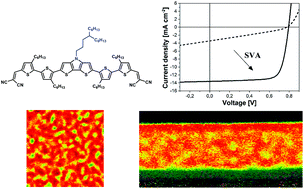The influence of branched alkyl side chains in A–D–A oligothiophenes on the photovoltaic performance and morphology of solution-processed bulk-heterojunction solar cells†
Abstract
Besides providing sufficient solubility, branched alkyl chains also affect the film-forming and packing properties of organic semiconductors. In order to avoid steric hindrance as it is present in wide-spread alkyl chains comprising a branching point position at the C2-position, i.e., 2-ethylhexyl, the branching point can be moved away from the π-conjugated backbone. In this report, we study the influence of the modification of the branching point position from the C2-position in 2-hexyldecylamine (1) to the C4-position in 4-hexyldecylamine (2) connected to the central dithieno[3,2-b:2′,3′-d]pyrrole (DTP) moiety in a well-studied A–D–A oligothiophene on the optoelectronic properties and photovoltaic performance in solution-processed bulk heterojunction solar cells (BHJSCs) with [6,6]-phenyl-C71-butyric acid methyl ester (PC71BM) as the acceptor material. Post-treatment of the photoactive layers is performed via solvent vapor annealing (SVA) in order to improve the film microstructure of the bulk heterojunction. The time evolution of nanoscale morphological changes is followed by combining scanning transmission electron microscopy with low-energy-loss spectroscopic imaging (STEM-SI), solid-state absorption spectroscopy, and two-dimensional grazing incidence X-ray diffraction (2D-GIXRD). Our results show an improvement of the photovoltaic performance that is dependent on the branching point position in the donor oligomer. Optical spacers are utilized to increase light absorption inside the co-oligomer 2-based BHJSCs leading to increased power conversion efficiencies (PCEs) of 8.2% when compared to the corresponding co-oligomer 1-based devices. A STEM-SI analysis of the respective device cross-sections of active layers containing 1 and 2 as donor materials indeed reveals significant differences in their respective active layer morphologies.

- This article is part of the themed collection: Organic Chemistry Frontiers HOT articles for 2017


 Please wait while we load your content...
Please wait while we load your content...